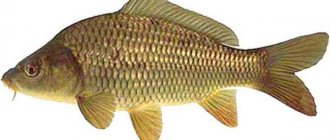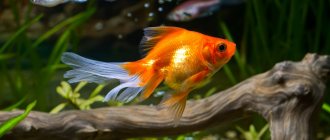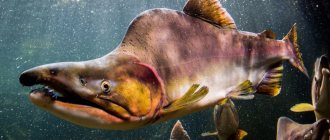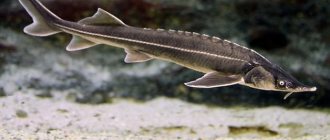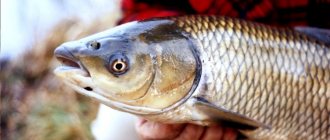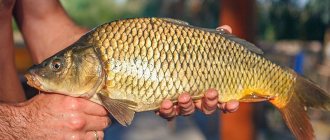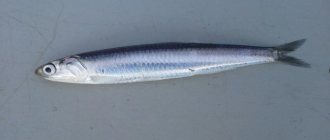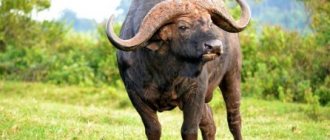Description
| Class: | Ray-finned fish |
| Squad: | Carp-like |
| Family: | Carp |
| Genus: | Carps |
| Scientific name: | Cyprinus |
| Homeland: | China and Southeast Asia |
| Habitats: | rivers, lakes, ponds |
| Nutrition: | omnivores |
| Weight: | average 1-5 kg, sometimes up to 50 kg |
| Lifespan: | 2-7 years, some live 50-100 years |
Carp are large freshwater fish. Among them there are predators, herbivores and omnivores. Carp is distinguished from other fish of this family, crucian carp and grass carp, by short antennae on the upper lip. Subspecies also differ from each other.
- River carp constantly have to fight the current to find food, so they are recognized by their elongated and elongated body and smaller size.
- Lakes and ponds are classified as closed reservoirs. The carp here are round in shape, quickly gain weight and are adapted to the lack of oxygen in the water.
Description of carp fish
It's hard not to recognize this handsome guy. If from a distance small koropchuk with golden sides can pass for crucian carp, then up close it is difficult not to see a large head with fleshy, well-developed retractable lips and two pairs of movable whiskers.
The body of the river pig is no less remarkable. Thick, moderately elongated, it allows you to easily identify the handsome fish even in advertising photos of carp fish (tackle sellers love and love the photogenic giant).
And looking at it in person, it’s hard not to pay attention to the fins. The dorsal one is low, long, with a small notch, the anal one is short. Both are equipped with a rough, spiny front ray.
The color of these fish depends on the characteristics of the habitat and belonging to a specific subspecies, of which there are more than a hundred in the CIS alone.
Origin of carp
There are two opposing versions:
The first claims that the carp was bred artificially by Chinese breeders using the genetics of domesticated carp. That’s why the name is translated as “domesticated carp.” Over time, through river canals and thanks to transportation, a new type of fish populated the waters of Europe, and then came to America. This version is considered erroneous.
The second version says that wild carp have long been considered an inhabitant of rivers and lakes. And they settled more often lake inhabitants. New, artificial breeds based on this variety of carp have been developed over the past 150 years for the biological improvement of species diversity.
When does carp bite well?
- On slightly cloudy, fairly warm and calm windless days.
- 15-20 minutes before the start of a thunderstorm.
- After long heavy rains, when good stable weather arrives.
- After a short rain, coming after a prolonged heat wave.
- With a weak wave, during a light drizzle.
- When the wind is directed in the opposite direction to the current.
- Bites well in south or southwest winds.
- During the flowering of hawthorn
What does carp look like?
Depending on the species, carp may differ in appearance. But this fish is easy to recognize by its external signs:
- the eyes are green-golden, set high;
- large body slightly humpbacked and plump;
- nose with double nostrils;
- large scales with a dark border;
- the sides are golden, slightly brownish in color; the abdomen is light; back dark;
- the color of the dorsal fin of a notched shape, which is crowned with a spiny ray, is grayish-olive; the short anal fin is also decorated with a spine;
- the mouth is large, elongated into a tube;
- upper lip with four short antennae.
Appearance of different types of carp
The body of the carp is covered with a protective layer of mucus.
Carp and carp - differences
Reservoirs of the basins of southern Russia, rivers and fresh sea bays are habitats for wild river carp. It would be more correct to call it common carp, which translates as “fish living in the mud.” And carp is a fish that is bred industrially using closed reservoirs. The wild representative, carp, has a more elongated body and smaller size.
The difference between carp and crucian carp
| Comparison details: | Carp | crucian carp |
| Mustache | present | No |
| Nose | with a hump | straight line |
| Lips | fleshy | thin line |
| Torso | plump, slightly elongated, flexible | higher than carp, laterally compressed |
| Scales | dark, large, soft | light, small, hard |
| Dorsal | large, with recess | light and small |
| Average weight | 5-50 kg | 2 kg - limit |
| Mobility | sedentary | chaotic movement |
comparison table
Carp feeding places (and feeding habits)
It is definitely worth noting that the intensity of carp feeding is variable. For example, in the winter months it is minimal, but in early spring or at the very beginning of summer it is already maximum. From approximately mid-June to mid-September, the feeding behavior of carp becomes measured, thanks to the large amount of food in the reservoirs. This period of the year is usually called feeding period. Since it is during this period of time that carp grow steadily and significantly gain weight.
In the summer season, carp (during the day) feed very often, alternating morning or evening meals with short-term fattening (exercises - respites). A significant part of the time (with the exception of the hottest hours - around noon) carp continuously search for food, actively scouting the bottom of the reservoir (or some underwater objects), using very sensitive whiskers. Like other peaceful fish species (i.e. not predatory), carp are actually omnivorous. Their priority food is plants (tender filamentous algae) or some kind of cereals (accidentally fallen into the water). Protein foods (small insects, worms, shellfish or crustaceans) make up only 5% of his total diet.
However, in early spring, when the carp gains strength after the winter “torpor,” the percentage of protein food consumption becomes very high. During this period of time, the eggs of spawning frogs (or other types of fish), various water bugs or worms (both dung and earthworms) are the main menu. But as soon as the water temperature rises, the carp almost (!) completely switches to dietary nutrition, since the serious need for energy-intensive/protein food automatically disappears.
A little about carp delicacies
An exception to the rule may be such “carp delicacies” as toothless or pearl barley, which are usually abundant in almost any freshwater ponds. In search of this “delicacy”, carp are ready to dig up (with the help of their “muzzle”) up to a hundredweight of mud (i.e. several tens of square meters of muddy bottom at once). Their hunt for toothless fish (regardless of water and air temperature) can last throughout the entire period of open waters. As a rule, in lakes or ponds rich in the above food (essentially, solid protein of the highest quality), carp grow (and gain weight) very quickly.
Toothless common (freshwater bivalve mollusk)
Another object of carp hunting is chironomids, i.e. larvae of the twitch mosquito (another name is the bell mosquito), better known to fishermen as “bloodworms”. Fish find them in a thick layer of silt, as well as on the rhizomes of algae, or under the bark of flooded trees. However, large carp do not feed on chironomids very often, preferring more “weighty” food. But, finding itself in a feeding area where there is an abundance of these ruby and very mobile worms, it happily eats them in very large quantities.
Chironomids - larvae of bell mosquitoes (or “bloodworms”)
On large lakes (or reservoirs) carp prey on molting crayfish. During the next molting period (from June to August), having shed its chitinous cover, it becomes completely unprotected against any fish, even non-predatory fish. Young crustaceans change their shell quite often (in the 1st year of life - 8 times, in the 2nd year - 5 times, in the 3rd year - 3 times). Therefore, in summer, in fact, they are the easiest prey. Being very sensitive, carp easily finds these crustaceans even in the most reliable shelters. And without much difficulty, it extracts them from under stones, shells, or from under constructed “walls” of algae or branches. In this case, the largest individuals swallow the crayfish whole, along with its “protective fortifications.”
Molting crayfish in the process of molting
Like other fish (of the “bottom” lifestyle), carp feed in schools (except for the largest individuals, which prefer to stay alone). As a rule, each such flock is immediately joined by several large crucian carp, feeding (and even wintering) together with the carp. They collect food, for the most part, from the bottom of the reservoir. Sometimes a couple of individuals, and after them the rest of the “brethren,” begin to look for food objects in the water column, as well as on the trunks and leaves of aquatic vegetation.
Closer to mid-summer, carp can feed at the very surface, eating the roots of duckweed, or, almost masterfully grabbing careless dragonflies sitting low above the water. By this time, all schooling fish (including carps) begin to actively feed at night, and during the day, on the contrary, to rest (in dense underwater thickets or buried in the bottom silt).
Streams, fords and livestock watering holes
Near streams flowing into a pond or lake, carp enjoy feasting on worms and tadpoles, which, as a rule, are “carried” into the reservoir - by the same stream flow. You may be surprised, but carp are absolutely not above eating the excrement of animals (horses or cows). The feces of which contain an impressive amount of semi-digested grains, grass or other equally nutritious substances. This allows fish to save time and energy searching for (and digesting) the required amount of food for the day. Therefore, flocks of them can often be found either somewhere near a ford, or near a watering hole. In the winter months (during a short-term thaw), usually completely torpid carp suddenly “come to life” a little and can grab with their mouth some small fish that accidentally swims by.
Features of lifestyle and behavior
Carps live in schools. Only larger fish stay apart, choosing deep places, but close to their relatives. They don’t like to leave settled places. While moving, they swim in a line consisting of fish of different ages.
Where are carp found?
The fish is heat-loving, so it is not found in the northern regions. The habitats of carp, like common carp, are temperate and southern latitudes:
- Ponto-Caspian-Aral region;
- Far East;
- Eurasia.
In 1970, silver carp were introduced into water bodies in the USA and Canada.
In Russia, carp lives in pools belonging to:
- Baltic;
- Japanese;
- Black;
- Caspian;
- Azovsky;
- Sea of Okhotsk.
Carp habitat
Freshwater fish live in a pond or in a weakly flowing lake, in flooded quarries, ponds, canals and reservoirs. Where carp live, reservoirs should have abundant vegetation on a soft, clayey or sandy bottom. For settlement, carp and carp choose places with warm water and a depth of 2-5 m. Large carp go to a depth of 10 m.
Carp is a cautious fish, so it does not live in open places with a flat bottom, but chooses areas with shelter. These are dense thickets, secluded holes, snags and bushes at the bottom. In winter, this fish gathers in schools, finding depressions, where they hide until spring, burrowing into the ground.
What do carp eat?
This is a voracious and omnivorous inhabitant of the reservoir. Before and after hibernation, it feeds more on animal food. In summer he switches to a plant-based diet.
Carp food includes:
- crustaceans and mollusks;
- fish and frog caviar;
- tadpoles with leeches;
- all kinds of insects with their larvae;
- flies, moths, worms;
- young shoots of aquatic plants.
Adults (large specimens) do not hesitate to eat even relatives and other neighbors in the pond, as well as frogs, crayfish, and try to grab birds landing on the water.
In times of famine, they feed on mucus that accumulates on plants and eat dung left by mammals.
Predatory fish or not
Carp is not an aggressive, calm and peaceful aquatic inhabitant, not a predator. Characterized by constant nutrition with increasing size. But some of the carp subspecies fight because they don't want strangers in their territory. Predators are distinguished by the fact that they hunt, and after eating the caught prey, they rest so that the food is digested.
Natural enemies
Large carp are rarely attacked; more often their eggs and juveniles suffer, which are eaten by green frogs. Also, it is a treat for crayfish, worms and other fish. Caviar washed ashore is destroyed by birds and other animals.
In addition, the fry are threatened by adult relatives, eating those who get in their way. And if caught, they themselves are eaten by a predatory pike or catfish. Man is also considered an enemy, destroying carp by catching fish.
What does carp eat?
Carp is considered an unpretentious and fairly omnivorous fish. Since the carp's mouth has a special design, the fish easily filters the bottom soil, releasing nutritional components. Thanks to this mouth design, the fish mainly feeds from the bottom. That is why the bottom method of carp fishing predominates. The pharyngeal teeth of carp are quite sharp, and the dense and wide lips are adapted for grinding fairly hard food objects. The basis of the carp diet includes:
- Larvae, worms, small crustaceans.
- Insects, molluscs and tadpoles.
- Caviar of other fish species.
- Aquatic vegetation, vegetables and cereals.
- Leeches and detritus.
The favorite foods of carp are molting crayfish and pearl barley. In places where carp live, you can hear a characteristic crunch, which indicates that the fish is crushing shells. This often misleads inexperienced fishermen. Large specimens can swallow a gaping fry, but carps do not specifically hunt them. This fish has excellent hearing, which allows it to hear a bloodworm swarming in the ground or an insect falling into the water from a distance of tens of meters.
Types of carp with photos
The genus of these fish unites more than 3 thousand species, including cultivated ones. But no more than 10-15 items are considered popular. Types of carp are often distinguished by color and arrangement of scales.
Common river
Common carp (carp) and its distinctive features:
- skin with a dense covering of large cycloid scales with dark edges;
- the body is elongated and raised higher than that of representatives of other species;
- golden or yellow-brown color dominates on the sides, the belly is widened and lightened, and the back is dark.
River common carp
It is considered a common hardy species and is used as a breeding base. This is how the mirror or scaly carp appeared.
Mirror carp
Sometimes called “German”, since it was in Germany that it was developed. Unlike the common one, this species has a round and massive body, with larger hard scales. Similar to small round mirrors, they are located only on the upper part of the body.
Based on the location of the scales, it is determined whether the carp belongs to the framed, scattered or linear subspecies.
Mirror carp
Instead of a golden color, sometimes there are individuals with brown sides. The fins are larger, but there are fewer rays. Mirror carp gain weight faster and feed mainly on cereals and shellfish.
Carp
To reduce the number of prolific, but small-sized crucian carp, a breed of carp carp was bred.
- They are hybrids, so they do not reproduce.
- The head and color of the species are similar to crucian carp, and the body is similar to river carp.
- No mustache.
The omnivorous breed is characterized by rapid growth (in 2 years - 2 kg) and valuable meat with a pleasant taste.
Karasekarp
Japanese Koi
Decorative goldfish were obtained in the 2nd century by crossing wild carp and local crucian carp. The inhabitants of aquariums are white, red, pink and spotted in color and reproduce independently. The length of individual koi representatives living in artificial reservoirs reaches 1 m. They are eaten.
Japanese koi carp
There are several species with different colors. In Japan, they are reflected not only in decor (koi is used to decorate ponds), but also in art, symbolism, and even became a folk tradition.
Koi color varieties
Golden carp
It is considered a large fish with a large and elongated body. The back, with serrated fins, is located high. The smooth scales are large, golden on the sides, dark on the back.
Golden carp are bred to decorate artificial ponds, so the color depends on the habitat.
On the large head there is a retractable mouth with a mustache and developed lips.
naked carp
This species is the result of further modification of the mirror carp.
- Naked carp have no scales at all, which is why they are also called leathery carp.
- But some large scales are found on the back and near the caudal fin.
Vulnerable fish. Intended only for artificial reservoirs. In addition, the new species has weak immunity and the fish often gets sick and is affected by parasites.
naked carp
Caspian carp
Another name is kutum, carp. Belongs to the carp family, but to the roach genus. It is distinguished by its large size, prefers fresh water, but sometimes swims into the low-salt mouths of rivers flowing into the sea. The body length is up to 60 cm, the weight of this delicious fish reaches 6-7 kg (usually up to 2 kg).
Kutum
Siamese carp
The most numerous species, which is often called the giant longhorned beetle because it weighs 40, sometimes even 150 kg, lives in the Indochinese basins.
A peaceful omnivorous inhabitant of local waters, it feeds on plants, algae, fruits, cereals and phytoplankton. Longhorned beetles grow up to 3 m in length. The scales are large and hard - the color of the body is influenced by the surrounding nature.
Siamese carp
Royal
The rare King Carp is often confused with the Mirror species.
- The main difference is the large size. Thus, young delicious specimens weigh 3-5 kg.
- Large and thick scales, golden and silver in color, sparsely spaced, literally like small islands.
Parsky carp
The habitat of carp is central Russia and the Black Earth Region.
To obtain a domestic fertile species, a hybrid carp and a seaside carp are crossed.
Parsky carp
The new specimens have thick scales that are yellow in color, and individuals weigh 4-6 kg.
Where do carp live (“reed”, “river” and “pond”)?
There are no significant differences (in terms of physiology) between the subspecies of carp. It is for this reason that in the scientific literature (in particular, devoted to ichthyology) carp (and carp) are considered to be a MONO/species, including minor endemic (i.e. tied to a geographical area) variations: river, lake, pond , semi-passing and “small”.
Carp very readily inhabit lakes and ponds, rivers and reservoirs, i.e. in fact, any body of water with a weak (or at most medium) current strength. Only with normally heated (warm) water! Being not particularly demanding on the oxygen regime, they can also be found in stagnant bodies of water. But under one important condition - the depth of the riverbed part of such ponds or lakes must be at least 3 meters.
In shallow water bodies, carp are quickly exhausted due to an acute shortage of protein food and oxygen. Although, in small ponds (up to 2 meters deep) you can easily find a fairly decent population of small carp. They do best in agricultural/irrigation canals. In fact, this fish has everything necessary for life: a weak current, not too deep (and stable, warm) water, as well as an excess of food and reed/reed thickets.
Irrigation canal overgrown with reeds/reeds - ideal conditions for “small”/“reed” carp
Reed/reed thickets
As for the last condition, we can safely say that the full settlement of certain reservoirs by carp directly depends on the presence of a normal amount of reeds/reeds on them. Since it is in such places that this fish finds a safe area (shelter, refuge), comfortable places for spawning and abundant “feeding areas”. Young reed shoots (sweet, soft and very juicy) are not only the carp’s favorite food, but sometimes the only one (for example, from the beginning of May to the end of June).
Thus, where there is very little reed/reed (or none at all) the carp population is extremely small. If only for the simple reason that spawning in these places is possible - not every year, and most of the spawned eggs are completely eaten not only by small predators and birds, but also by their own relatives.
Like lake perch, in the territory of coastal reeds, carp (over time) form their own special subspecies, under the names: “small” or “reed” carp. As a rule, individuals of the above population never leave coastal zones. In appearance, they are virtually no different from young carp, with the exception of the ability to spawn at very small sizes. “Small” / “reed” carp grow very slowly, and in the rarest cases they “gain” weight - more than one and a half kg.
Where do carps not like or cannot live?
First of all, carp do not like record depths, therefore, in peat or granite quarries there are practically none. Sufficiently deep basins, often with a complete absence of shallows (in the relief), are unsuitable for the normal life of this fish. However, all of the above/said absolutely does not apply to scaly carp, which often lives in the deepest quarries, and (over the years) grows - simply to a gigantic size.
The only places where carp are not able to survive at all are mountain (usually very fast) rivers and forest lakes with stagnant water. In the latter, this fish cannot live due to the insignificant amount of food and too cold water, “beating” into these lakes from underground springs. However, even in Siberia, carps are able to take root well in artificial ponds, and at fairly large depths.
The seething stream of a (cold) mountain river is absolutely unsuitable for carp habitat
Where do wild/river carp live?
As a rule, carp prefer a sedentary lifestyle. Only in the most extreme cases can he be forced to leave his favorite stop. Small river carp usually constantly “swarm” in fairly dense coastal thickets. And large individuals prefer snags (at depth), support or underwater caves (often living next to catfish).
Carp, or, as it is also called, wild river carp, inhabits wide reaches of large and medium-sized rivers, backwaters, oxbow lakes and other areas with slow flows. He especially likes to settle in small and quiet rivers, not far from where they flow into larger ones. Carp actually never go to the main line, except for the largest and strongest individuals, who do this (not often) for fattening (i.e., a kind of exercise). In river deltas that flow into warm seas, river carp form a “semi-anadromous” subspecies, inhabiting both the river delta itself and weak/salty estuaries, as well as desalinated areas of the sea.
Where do pond carps prefer to live?
The so-called “pond” carps (i.e. those living in ponds, lakes or reservoirs) inhabit all feeding areas of the reservoir at a depth of 1 to 3 meters. Large individuals can live comfortably at great depths. However, it must be near any shelters or some uneven bottom topography. It is definitely worth noting that even when settling at a decent depth, carp regularly go to the shallows (well warmed by the sun and rich in food).
The favorite place to stay for pond carp is the borders of reed/reed thickets, with a stepped slope going towards the riverbed. Like other schooling fish species (for example, bream, crucian carp or silver bream), carp often move both along and across the dump in search of food. And if necessary, they find safe “shelters” in coastal thickets. The larger the pond carp (in size and weight), the greater the depth at which they seek shelter. As a rule, support or snags are chosen.
Reproduction and spawning
Carp is a heat-loving fish; to spawn, it waits until the reservoir warms up to 18-20 degrees to a depth of 0.5-1.5 m. Then it chooses a shallow area in reed thickets. Here the female lays portions of eggs, with a total number of up to 1 million future fry, which appear on the 4-7th day. For the first 2-3 days they feed on the yolk of eggs, then they switch to feeding on zooplankton.
How to distinguish a male from a female
Male and female representatives of the species are distinguished only after reaching sexual maturity: males become adults after 2-3 years of life, females - 2 years later. The main difference is the size of the carp.
- Female specimens are 6-7 cm larger than male specimens. For spawning, males need their body to be at least 30 cm, and females - at least 37.
- In addition, the cheeks, back of the head, front fins and gill covers of males are covered with whitish warts.
- In some species, males and females differ in color and anal openings - in the female it is swollen, enlarged, oval in shape and red in color; the female genital opening is compared to a triangular fold.
- Also - by behavior - spawning females become warlike, and the laid eggs are guarded by “men”, becoming aggressive at this time.
Growth rate, average size and weight
First of all, the growth of carp depends on nutrition.
- By six months, the weight of constantly feeding fry already reaches 0.5 kg.
- Fish raised on special food weighs 8-10 kg by the age of 7 and reaches a length of half a meter.
- In a natural reservoir, the food supply is poorer, so wild carp gain such weight only by 14-16 years.
The second condition: the reservoir and its size.
- Large specimens will not grow in a small, unkempt pond.
The third factor is the presence of open water, where there is no crowding. Is it a lake or a river.
- Here you can find fish 150 cm long and weighing more than 25 kg.
How long do carp live?
The lifespan of these fish is directly affected by the environment in which they live. Carps grown artificially acquire better marketable condition after 2-3 years and are subject to harvesting. Wild representatives of the species, living in a natural body of water, live 30 years or more. This is influenced by water temperature and diet with the amount of feed.
Fishermen often come across 2-7 year old carp, weighing 1-6 kg. “Old men”, at the age of 45, are a rarity. The lifespan of decorative species is more than 100 years.
When does carp spawn?
The breeding season begins at the end of April-May. The water should warm up to a comfortable +18-20 degrees. If the year began with a cold, long spring, carp may come to spawn even in June. Sexual maturity in males and females occurs at the age of 4-5 years. It is not for nothing that carp are considered a very prolific fish: the eggs laid by one female in a season can contain up to a million eggs.
Cyprinids spawn in shallow water in thickets of reeds or algae. The eggs are laid in portions over several days and are fertilized by several males at once. Under favorable conditions, the fry appear on the fifth or sixth day. At first, they get everything they need for growth from the yolk sac, and then they switch to zooplankton.
CRUCCIAN
Interesting facts about carp, records
- Because the fish is unpretentious and does not pay attention to water pollution, and its main concern is food, its middle name is water pig.
- Japanese rice farmers were often unable to travel to buy food due to weather conditions. The lack of protein food was compensated for by farmed carp living in reservoirs, from which the plantations were watered.
- A 70-year-old Japanese man takes care of a carp that he inherited. The age of the fish is 105 years. The owner is offered large sums, but he categorically refuses to sell the pet.
Features of appearance and its dimensions
Common carp can be easily identified by a number of characteristic features. For example:
- The fish has a thick, tall and slightly elongated body.
- The body is covered with large, tightly fitting cycloid scales with a dark edge.
- The sides are distinguished by a golden or yellow-brown hue.
- The belly is wide, light in color.
- The mouth is large, which can extend into a tube.
- On the upper lip there are 2 pairs of sensitive but small whiskers.
- The eyes are high-set, with small pupils and golden-green irises.
- The back has darker shades. There is also a long dorsal fin of a gray-olive hue with a characteristic but shallow notch.
- The nostril openings are double.
Among other things, the carp’s body is covered with a layer of mucus, which reduces resistance to water movement, improves thermoregulation processes and protects the body from all kinds of parasites and infections.
At the same time, the fish can grow to impressive sizes, gaining considerable weight. There is official data that specimens were caught that were more than one and a half meters long and weighed about 55 kg. The average statistical size of individuals present in fishermen's catches weighs no more than 5 kg. Carp is considered a long-liver, as it can live more than 50 years. There are decorative varieties for which we will cross the 100-year mark.
Interesting fact! In the land of the rising sun, a 70-year-old Japanese man inherited a carp that lived in a pond and was 35 years older than him. The Japanese treated fish as a member of their family. He was offered several times to sell the carp for 20 thousand dollars, but the Japanese flatly refused.
Fishing for carp
- Success awaits the fisherman in warm, stuffy and cloudy weather with a weak southwest or southeast wind direction.
- They also make sure to look at the atmospheric pressure, which should be low.
- The chances of catching a trophy increase during the early morning and evening.
- Places with cloudy water are preferable to places with clear water.
Sport fishing for carp is called “carp fishing”. This is trophy fishing, the main principle of which is catch and release. At the same time, great attention is paid to the safety of the fish: special hooks are used, methods of fishing, and even releasing the fish back into the reservoir is done as safely as possible for it. A mandatory attribute is to take a photograph with the trophy. Carfishing, although popular all over the world, is technically quite complex, which requires professionalism and investment from carp anglers.
Peculiarities
Carp is considered a cautious, cunning and unpredictable fish, moreover, strong and intelligent, which is not so easy to catch. To do this, you need to learn everything about carp, choose the right place to fish, select suitable gear, groundbait and bait (carp has a keen sense of smell).
It is easier to catch spawned animals because they are hungry, so they are less wary.
It's better to go catching when it's warm and quiet. In rainy, cloudy weather, carp feed at any time of the day or night. What makes catching fish easier is that it does not like to travel and prefers sedentary places.
Cool calendar, best period
- In winter, carp sleeps and wakes up hungry closer to May, when the water warms up to 10-12 degrees.
- Before spawning, it feeds, gaining strength.
- During the mating season and laying eggs, it goes hungry.
- In June, when the spawning ends, a round-the-clock fish feast begins. But in many regions, carp fishing is allowed only after 1.5-2 weeks.
- In July they behave calmly, and from August they begin to gain fat, preparing for winter suspended animation. At this time, the carp is actively hunting and is happy with any bait.
- It goes into hibernation more often in October - the biting stops.
Fishing methods, gear and bait
Carp are most often caught with a feeder, bottom or float rod.
More often they fish using the bottom method, because the fish’s favorite place to search for food is the bottom.
They lure with peas and corn or worms, bloodworms and maggots. Before throwing the bait, the area is fed with barley, peas and corn soaked for 12 hours. It is recommended to flavor the bait mixture with caramel, vanilla or garlic.
The carp that has swallowed the bait is pulled up carefully and slowly. At the same time, you should not interfere with its movement in a circle.
Predator or not
The carp fish, like its wild ancestor the carp, is not a predator, since it has no teeth. The river subspecies is popularly called the water pig, as it is omnivorous. There is almost always carp fish, even in the cold season, when its activity decreases. In warm weather, its diet is dominated by:
- plants;
- shellfish;
- crustaceans;
- insects, fish and frog eggs;
- leeches;
- water striders
The carp fish, or korop, as it is called in Ukraine, is not a predator, so it constantly feeds and grows for a long time, increasing in size. Predatory freshwater ichthyofauna always has teeth and after a hunt is in a state of rest, digesting the eaten prey, which cannot be said about cyprinids that live in freshwater bodies of water and prefer stagnant water.
Predators include the asp, which is part of the carp family of the order Cypriniformes. It has teeth located in the larynx and can feed on young fish. The predatory fish asp, like other carps, also feeds on aquatic plants and insects.
Scientists tell interesting facts about this fish. She eats only what she likes, sucking up the food first and then spitting it out, choosing only what she likes. A predatory fish with teeth never spits out food.
Fishermen also tell interesting facts about carp, which has excellent memory. He will give up his favorite food if he was caught eating it at least once and then got off the hook. This fact is confirmed by ichthyologists.
This fish is very popular in Southeast Asia. A number of researchers claim that it was bred in Ancient China and Ancient Rome. Today she is called the king of amateur and sport fishing.
@AlisLuch-depositphotos.com
Use in cooking
Fleshy fish from fresh water bodies have long been valued for their taste and benefits for the body.
Nutritional value of carp
100 g of this product contains no more than 112 kcal. Therefore, carp meat is an indispensable food for a gentle and dietary diet.
But, it is worth considering that a fried dish increases its energy value by more than 2 times. So those who are losing weight or who do not want to gain weight are advised to eat boiled, stewed or baked carp.
Chemical composition
The meat of river fish, including carp, is rich in minerals necessary for the human body: phosphorus and iron, magnesium, calcium and iodine. And also nutrients, vitamins B, A, C and PP, especially a lot of protein. In addition, carp meat contains proteins and a large amount of Omega-3 and 6 polyunsaturated fatty acids.
Beneficial features
Carp do not feed on carrion; their menu consists only of algae, plants and shellfish, so the meat is clean and healthy and does not cause harm.
With regular consumption of fish dishes, bone tissue is strengthened, mental activity is normalized, and there are no disturbances in the functioning of the heart and blood vessels. There is a strengthening of the immune system, the appearance of strength and energy, as well as a slowdown in aging.
Harm and contraindications
Artificially farmed carp meat is not always beneficial. The reasons for this are different:
- The first thing you should pay attention to is that fish often contains parasites, so it is recommended to boil and fry the meat;
- due to high-calorie additives, harmful fat is added to meat and cholesterol, which is dangerous for humans, accumulates;
- treating fish with antibiotics remaining in the meat weakens human immunity;
- small bones are dangerous for the throat and sometimes injure the esophagus.
- Another danger of carp meat is an allergic reaction in people susceptible to such products.
Taste of carp
Commercially farmed carp are fed a healthy diet that contains fiber, protein and fat. But dietary supplements that accelerate growth, antibiotics, flavorings and food dyes spoil and worsen the taste of fish grown in fish farms.
In wild species, the meat is healthier, has a pleasant sweetish taste, is tender and juicy.
Is the meat bony?
Carp is not considered a very bony fish. The bones are large, but there are few of them. But some people consider the meat of this fish to be bony because of the occasional small bones.
Let's put it this way - when compared with sea fish, carp meat is bony, but among freshwater fish (which carp belongs to) there are few bones in it.
How to choose the right one in the store
When choosing carp or carp, it is recommended to give preference to fresh fish. Indicates freshness:
- difficult separation of bones;
- pulp elasticity;
- protrusion and transparency of the eyes;
- moisture of the scales, on which colorless and slippery mucus remains;
- The color of the gills is bright pink or bright red.
If the carcass is frozen, choose one with an even glaze, which means the freezing was done correctly. Dry freezing does not leave the glaze, but makes the fish look like a smooth stone.
The mirror view is considered the best for choosing carp. When choosing a carcass, they look at its cleanliness; 2-3 bloody marks are allowed.
The nutritional value
If we consider the nutritional value of this fish, it is worth highlighting the following key characteristics:
- Calorie content – 112 calories.
- Proteins – 17 g.
- Fats – 5.5 g.
- There are no carbohydrates in fish - 0 g of this substance in carp makes it a valuable dietary product.
- The largest number of vitamins is represented - B1, B4, B6, B12, D, PP.
- Of the micro- and macroelements in larger quantities, one can distinguish here - magnesium, phosphorus, potassium, calcium, sulfur.
Carp recipes
Carp is baked using foil or grilled, fried, stewed, boiled and pies are baked with it. Meat, cleaned from bones, is suitable for making meatballs, meatballs and cutlets.
Carp fried in a frying pan
- Clean and wash the carcass, cut off all excess and cut into pieces 1-5 cm wide.
- Salt, pepper and mix in flour. Fry in vegetable oil.
- Separately, over medium heat, fry onion half rings. Then pour in the fish pieces, turned over and fried for 5 minutes.
- Cover with a lid and simmer for 7 minutes.
- To serve, sprinkle with dill and lemon juice.
Carp in the oven
- The scales are removed from the fish carcass and washed thoroughly.
- Rub with a mixture of salt and pepper, then stuff with chopped herbs and garlic-sour cream sauce. Thin lemon slices are placed on top.
- Baking time 50-60 minutes. The result is a juicy and tasty dish.
How to catch carp.
It is useful to attach fish to fishing areas. As a top dressing, you can use steep millet porridge, crackers from leftover bread and steamed barley. Use steamed hemp seeds for bait. In places where balls of bait lie on the bottom, air bubbles soon begin to float up - this means that the fish has approached and begun to feed. Feeding should be added in small portions before fishing and during the period when the bite subsides. During the day you need to change the bait periodically. Silence must be maintained. Large carp prefer silence; they bite in very quiet places, where you can’t even hear the crow of roosters. For successful carp fishing, be sure to carefully read all the tips in our carp biting forecast for your region.
Author of the article: Team of authors of the site orybe.com 2014-01-19
Where do carps live?
Carp fish live and are found in almost any water. It is bred by fish farms in huge quantities in artificial reservoirs, rented lakes and reservoirs. From time to time, carp escape from fish farms, run wild, and populate adjacent rivers, lakes and other bodies of water.
Rarely found in rivers, they prefer to stay in areas with silted bottoms and weak currents, oxbow lakes and creeks.
In each body of water, fish adhere to its own rules and preferences, despite the wishes of the fishermen.
Experienced carp anglers studied them. But beginners would not mind exploring the feeding areas and “dens” of carp, learning the habits and behavior of the fish at different times of the year.
How fish behave in winter - in hibernation, in spring - in hunting and reproduction, in the summer heat, in August and autumn.
However, only with experience comes catching not only young of the year in the platform, but also trophy heavyweights - old carp, wise in life and with the same experience.
Carp feeding
So, what can be deduced in common from the numerous observations of experienced fishermen and hunters.
- In each individual reservoir, the carp lives as and where it wants. Carp can be found absolutely everywhere - in the grass, in rubble, in snags, on riffles, in a hole or under the shore. But there are some patterns, read on...
- Carp pits and sites are easy to spot from a boat in clear weather and relatively clear water in not very deep lakes and reservoirs.
- Large carp exist and are found in large numbers in many bodies of water, despite the immobilization of the fisherman's float.
Seasonal migrations
In late autumn, when the temperature drops to 2-3 degrees, carp migrate to the deepest holes for the winter.
From May to June, carp usually leave their habitats in and around holes and move to spawn closer to the coastline or on the shallows. At this time, wintering and feeding areas will be dusted with silt.
In June, having spawned, the carp returns to its favorite areas, sweeps out holes and continues its usual way of life.
Where to look for carp in the heat
By the way, where to look for carp in the pond in the heat? Near the surface. Whole schools of fish will hover just below the surface of the water, fanning themselves with their fins. This is due to problems with oxygen in the water.
At this time, the fish will stay in shallow water at a depth of up to 1.5 meters or near the shore in thickets of reeds, reeds, and sedges.
Places where carp spawn
One of the most important events in the life of almost any species of fish is the spawning period. And in carp it often begins – later than others, that is, until the water warms up to at least a temperature of +15 °C. And in general, spawning becomes widespread only after the water warms up to +18°C! Then almost all schools of carp are divided into small groups: consisting of one female and a pair (or three) of males accompanying her. After which they begin to actively search for a safe place - at the same time shallow, but also well protected. That is, for example, quite dense thickets of algae, backwaters or oxbow lakes. And they do all this in order to calmly sweep away the milk and caviar.
The vast majority of lake and pond carp prefer to spawn in coastal reed/reed thickets, which, by the way, are very convenient for “grating”. This type of fish behavior has such a strange name because carps, in the most natural sense of the word, continuously rub at this time, both against each other and against the reed stems. The thing is that it is during the spawning period that all the scales of males are covered with small growths. That's why they constantly rub their rough sides in order to significantly facilitate the release of reproductive products.
“Fierce grater” of carp in shallow water during the spawning period
Carps love to spawn - both in water meadows, and in small swamps, and even in some puddles that are somehow connected with a lake, pond or river. Not only small, but also quite large fish often reach such spawning grounds “crawl”, climbing on their sides - either along a more or less muddy “path”, or directly along damp grass. Sometimes carp can even choose places for spawning where the water does not completely cover them. This, of course, is what the locals “criminally” take advantage of, collecting fish by hand, guided by the fins (dorsal), “treacherously” sticking out on the surface.
Peculiarities of spawning of river carp (carp)
After the water recedes, carp often find themselves in “traps”. Those. they remain in tiny isolated lakes, where they die very quickly, being cut off from the riverbed by too wide a stretch of land. In the riverbed itself, usually only the largest individuals of river carp (i.e. wild carp) spawn, and only after the river has returned to the banks.
Spawning of carp living in large rivers has its own specific characteristics, which are very different from spawning in ponds or lakes. How do they manifest themselves? As soon as the water warms up to normal temperature, several individuals separate from the school of carp (carp) and move upstream. In order to thoroughly study the coastal zone in order to find the most convenient site for spawning. At this time, the rest of the flock slowly follows (often at a distance of several kilometers), actively feeding along the road.
The scout carp is on a responsible mission!
After the “scouts” manage to find a good spawning area, they return back and lead the entire flock with them. Which no longer lingers - neither for food nor for rest. Having spawned, the carp return down again to their usual wintering places, or simply disperse along the riverbed and tributaries (if the river is small in width). However, this kind of “pre-spawning reconnaissance” does not always happen. And if it happens, then this indicates favorable factors in the reservoir, the growing number of carp stocks and the active development of new territories by fish. However, carps never swim too far from their permanent sites.
